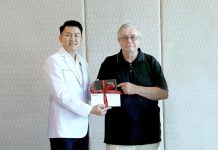Mrs. Gonzales was your typical Gibraltarian Mumma. Around 20 stone in weight, give or take the odd kilogram or six. These Gibraltarians, descended from the mainland Spanish, were all very similar. Obese and not particularly stoic, tending towards the histrionic when under stress. “Oy, Oy, Oy, me dwelle mucho!” (I am in much pain) was regularly heard in the Casualty department before the diagnosis of blisters from new shoes and the medically applied Band-Aid handed out. Mrs. Gonzales was one of these.
She presented at outpatients with a history of alternating diarrhoea and constipation for some months and now she noticed that there were some hard lumps in her stomach. Some? She had lots. My boss, Mr. Toomey, was one of the last of the British colonial surgeons and I asked him to see her.
Mr. Toomey confirmed the presence of the lumps with his experienced hand, and told me the diagnosis. Mrs. Gonzales would have disseminated cancer and would be inoperable; however, we would open her up to confirm the diagnosis, but that would be as far as the operation would go, he said. Open and close.
On the Tuesday, Mrs. Gonzales was prepped and a large abdomen awaited us. Mr. Toomey made a mid-line incision and we did not have to go further. Large grey/white lumps, firmly adherent to everything, greeted us. We did not count how many. It was pointless. It was, just as Mr. Toomey predicted, simply everywhere. We had opened, and we closed.
Mrs. Gonzales was returned to the ward after being sewn up and the gravity of the situation was later explained to her. We could not help. There were limits to medical science, expertise and knowledge (and there still is), but we would make her last remaining weeks as comfortable as possible, while she came to terms with her personal God (Gibraltar, like Spain was predominantly Roman Catholic).
Mrs. Gonzales reacted to the bad news with none of the expected wailing and gnashing of teeth, but by telling us that she would be getting better and she would be going home for Xmas. “In a wooden box,” I thought to myself.
The post-operative phase was not uneventful. The cancer tissue came through the wound and we now had an abdominal ulcer that was never going to heal. Daily dressings and wound cleaning was all that could be done, she was, after all, terminal.
It did not stop there. The cancer then eroded through the bowel, so now there was a direct passage for the faecal matter to get to the outside. It was quite horrible. The smell was so bad we had to put her in a private room, as the other patients in the ward began to complain. And yet, all the time, Mrs. Gonzales said she would be going home for Xmas. I did not change my opinion. It would be on a pine box.
However, after three months, the seemingly impossible occurred. Her inoperable multiple cancerous lumps had disappeared, along with the abdominal discharge. It had healed over! When I told Mr. Toomey, he also did not believe me, but after examination had to agree that clinically there was no cancer evident, and the abdomen was clear.
Mrs. Gonzales did indeed go home for Xmas, waddling proudly out of the hospital to the waiting taxi. She thanked us all for what we had done, but I felt embarrassed. We doctors had done nothing to get her over her cancer problem. The nursing staff had done far more than we had, but the final outcome was all down to Mrs. Gonzales’ personal faith. Her personal ‘Higher Physician’ was obviously not ready for her, even though we had mentally consigned her to crossing the River Styx.
(Footnote: In this day and age, with medical technology so much more refined, there are many more procedures we could use to evaluate Mrs. Gonzales’ condition such as CT scans, Magnetic Resonance Imaging (MRI) and even colonoscopy. However, these would not have changed the outcome, they are merely diagnostic tools, and not definitive treatment, and would not replace the practised surgeon’s hand on the abdomen, which was about all we had on the rock of Gibraltar in 1967.)




